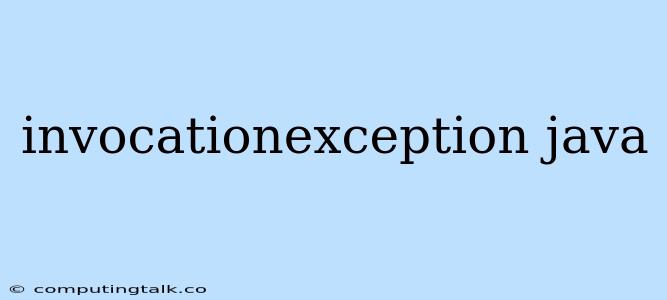The InvocationTargetException in Java is a common exception that arises during method invocation, specifically when a target method throws an exception. It acts as a wrapper, carrying the original exception thrown by the method. This article will delve into the intricacies of InvocationTargetException, exploring its causes, handling mechanisms, and real-world examples.
Understanding the InvocationTargetException
Imagine a scenario where you want to execute a method residing within a different class. You employ reflection to achieve this. However, the target method encounters an unforeseen issue and throws an exception. This is where InvocationTargetException comes into play.
What is InvocationTargetException?
It's a checked exception in Java, meaning you must either handle it explicitly or declare it in the method signature. This exception indicates that a target method, invoked through reflection, has thrown an exception.
Why does it occur?
InvocationTargetException arises when:
- Target method throws an exception: The method you invoke through reflection throws a different exception, such as
ArithmeticExceptionorNullPointerException. - Access issues: The method you try to invoke is inaccessible due to permission restrictions or the invoking class's lack of access rights.
How to Handle InvocationTargetException
The primary approach to dealing with InvocationTargetException involves using a try-catch block. The InvocationTargetException is caught, allowing you to extract the original exception that caused it.
Example:
try {
Method method = targetClass.getMethod("targetMethod", String.class);
Object result = method.invoke(targetObject, "Hello");
} catch (InvocationTargetException e) {
// Extract the original exception
Throwable targetException = e.getTargetException();
// Handle the original exception based on its type
if (targetException instanceof ArithmeticException) {
System.out.println("Arithmetic error occurred: " + targetException.getMessage());
} else if (targetException instanceof NullPointerException) {
System.out.println("Null pointer exception occurred: " + targetException.getMessage());
} else {
// Handle other exceptions
}
} catch (NoSuchMethodException | IllegalAccessException e) {
// Handle reflection-related exceptions
}
In this code, we attempt to invoke the targetMethod using reflection. If an InvocationTargetException occurs, we retrieve the original exception using getTargetException() and handle it based on its type.
Real-World Applications
The InvocationTargetException is often encountered in scenarios involving:
- Reflection: When dynamically invoking methods using reflection, you are susceptible to
InvocationTargetExceptionif the target method throws an exception. - Dynamic Proxies: In scenarios where you use dynamic proxies to intercept method calls, the proxy implementation might throw an exception, leading to
InvocationTargetException. - Third-party Libraries: Libraries utilizing reflection might throw
InvocationTargetExceptionif underlying methods fail.
Troubleshooting and Debugging
When confronted with InvocationTargetException, the key lies in identifying the original exception.
Debugging Tips:
- Inspect the stack trace: Carefully analyze the stack trace to pinpoint the exact location of the original exception.
- Examine the target method: Verify the target method's logic and potential exceptions it might throw.
- Check permissions: Ensure the invoking class has sufficient permissions to access the target method.
Conclusion
The InvocationTargetException in Java signifies an exception thrown during method invocation through reflection. Understanding its causes, handling mechanisms, and real-world applications empowers you to effectively address this exception and maintain robust code. Remember to always catch and handle InvocationTargetException appropriately, extracting the original exception for proper diagnosis and resolution.
